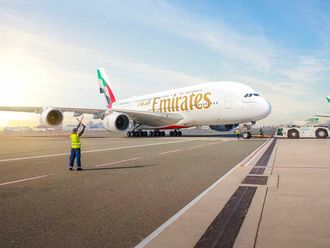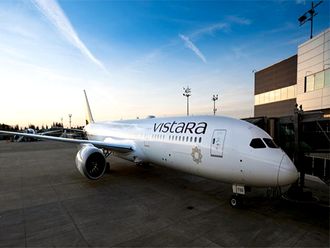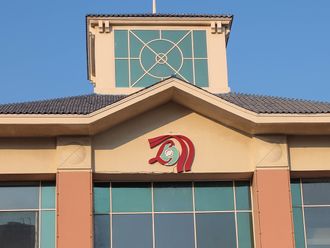London: European low-cost airline easyJet unveiled plans Friday to fit its planes with radar to detect volcanic ash.
EasyJet said the devices — designed to be placed on the tail fin and detect ash within 100 kilometres — are the first of its kind and could prevent a repeat of the shutdown of European airspace last month caused by an erupting Icelandic volcano.
The airline is spending £1 million (Dh5.3 million) developing and testing the technology with aircraft manufacturer Airbus and hopes to trial the devices in a dozen of its planes by the end of the year.
The Avoid (Airborne Volcanic Object Identifier and Detector) technology involves a lightweight infrared device that supplies images to both the pilots and an airline's flight control centre, enabling pilots to see an ash cloud at altitudes between 5,000 feet and 50,000 feet.
"This pioneering technology is the silver bullet that will make large-scale ash disruption history," easyJet CEO Andy Harrison told reporters in London.
"The ash detector will enable our aircraft to see and avoid the ash cloud, just like airborne weather radars and weather maps make thunderstorms visible."
In need of approval
However, the devices will need approval from regulators across Europe and industrywide adoption to have a significant effect.
Harrison said that easyJet hadn't worked out the commercial details, but intended to share the technology.
"What we don't want to do is to gain a commercial advantage over other airlines so we can fly and they can't," he said.
"This is a huge leap forward and the best thing is to get this technology on hundreds of planes operated by a number of airlines."
The unprecedented closure of European airspace in April caused direct losses of more than $1 billion euros ($1.3 billion) to the airlines affected, and as much as $1.5 billion euros ($1.95 billion) to other businesses.
Millions of passengers were stranded as flights were cancelled, turning to boats, trains and cars to get to their destinations.
Few doubt that flying a plane directly into the plumes of a volcano could disable the aircraft.
Unclear cause
But it remains unclear whether the abrasive particles present a hazard to the jets outside the immediate area of the volcanic plume, once it is dispersed by high-altitude winds.
Airlines have blamed European regulators for overreacting to what they say was a manageable threat and have demanded that internationally recognised standards of ash contamination be set.
EasyJet, which lost £55-£75 million because of the closure, is one of a number of airlines seeking compensation from governments.
Andrew Haines, the chief executive of Britain's Civil Aviation Authority, welcomed easyJet's testing of new technology.
"I very much hope this is a sign that the industry is going to play its part ... rather than pretending the risk doesn't exist," he said.
Haines defended the decision to close airspace during the height of the crisis, saying aircraft manufacturers did not provide any information about what was a safe level of ash.
"Until we could get a clear assessment, we were absolutely justified in taking the actions we took," he said.
"Otherwise, it would have been a case of keeping our fingers crossed and I don't think anyone would have thanked us for that."
EasyJet plans to carry out its first test flight on an Airbus A340 test plane within two months.
Depending on the results of those tests, it will then move to the wider trial on its own aircraft.
IATA to work past ash cloud crisis at Berlin meet
Top executives of the world's biggest airlines will gather in Berlin this weekend, seeking elusive answers to the future of the industry as they move past the financial crisis and the damage from Iceland's ash cloud.
The International Air Transport Association (IATA) holds its annual meeting in the German capital from June 6-8, followed by the ILA Berlin Air Show from June 8-13.
No one expects a sunny forecast from IATA given the industry's woes. The question, instead, is how bad is "bad" and what can airlines do to turn their fortunes around.
"I don't think one will be able to say ‘here's a concrete result of the AGM' but I think the purpose of it all is just to provide a forum where particular issues important to the industry may be raised and communicated to the public in order to influence lawmakers and regulators around the world," said Per-Ola Hellgren, an airlines analyst with LBBW in Germany.
"I think the most immediate one is to provide some kind of framework for how the industry would like the shutdown of airspace to be regulated in future volcano ash crises," Hellgren added.
"I think that's going to be sort of the headline issue."
The Icelandic ash plume came at perhaps the worst possible time for the industry. The late-April closure of much of Europe's airspace for the better part of a week cost airlines as much as $1.7 billion, IATA has said.
IATA head Giovanni Bisignani called it "devastating" for an industry already forecast to lose more than $12 billion last year and this.
While the threat has faded in Europe, others have popped up elsewhere.
A volcanic eruption in Guatemala last week closed the country's airport and spewed ash 5,000 feet high, while another in Ecuador had the same effect.


_resources1_16a0854a7aa_small.jpg)









